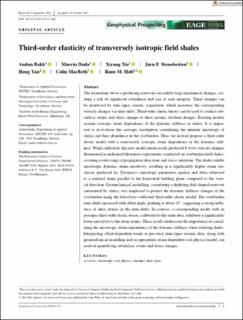| dc.contributor.author | Bakk, Audun | |
| dc.contributor.author | Duda, Marcin | |
| dc.contributor.author | Xie, Xiyang | |
| dc.contributor.author | Stenebråten, Jørn | |
| dc.contributor.author | Yan, Hong | |
| dc.contributor.author | MacBeth, Colin | |
| dc.contributor.author | Holt, Rune Martin | |
| dc.date.accessioned | 2024-03-05T11:42:43Z | |
| dc.date.available | 2024-03-05T11:42:43Z | |
| dc.date.created | 2023-10-24T09:41:58Z | |
| dc.date.issued | 2023 | |
| dc.identifier.issn | 0016-8025 | |
| dc.identifier.uri | https://hdl.handle.net/11250/3121080 | |
| dc.description.abstract | The formations above a producing reservoir can exhibit large mechanical changes, creating a risk of significant subsidence and loss of rock integrity. These changes can be monitored by time-lapse seismic acquisition, which measures the corresponding velocity changes via time-shifts. Third-order elastic theory can be used to connect subsurface strains and stress changes to these seismic attribute changes. Existing models assume isotropic strain dependence of the dynamic stiffness in shales. It is important to re-evaluate this isotropic assumption considering the inherent anisotropy of shales and their abundance in the overburden. Thus, we instead propose a third-order elastic model with a transversely isotropic strain dependence of the dynamic stiffness. When calibrated, this new model satisfactorily predicted P-wave velocity changes determined in undrained laboratory experiments conducted on overburden field shales, covering a wide range of propagation directions and stress variations. The shales exhibit anisotropic dynamic strain sensitivity, resulting in a significantly higher strain sensitivity predicted for Thomsen's anisotropy parameters epsilon and delta subjected to a uniaxial strain parallel to the horizontal bedding plane compared to the vertical direction. Geomechanical modelling, considering a depleting disk-shaped reservoir surrounded by shales, was employed to predict the dynamic stiffness changes of the overburden using the laboratory-calibrated third-order elastic model. The overburden time-shifts increased with offset angle, peaking at about 45 degrees, suggesting a strong influence of shear strains on the time-shifts. In contrast, a corresponding model with an isotropic third-order elastic tensor, calibrated to the same data, exhibited a significantly lower sensitivity to the shear strains. These results underscore the importance of considering the anisotropic strain dependence of the dynamic stiffness when studying shales. Interpreting offset-dependent trends in pre-stack time-lapse seismic data, along with geomechanical modelling and an appropriate strain-dependent rock physics model, can assist in quantifying subsurface strains and stress changes. | en_US |
| dc.description.abstract | Third-order elasticity of transversely isotropic field shales | en_US |
| dc.language.iso | eng | en_US |
| dc.publisher | Wiley | en_US |
| dc.relation.uri | https://onlinelibrary.wiley.com/doi/abs/10.1111/1365-2478.13446 | |
| dc.rights | Attribution-NonCommercial-NoDerivatives 4.0 Internasjonal | * |
| dc.rights.uri | http://creativecommons.org/licenses/by-nc-nd/4.0/deed.no | * |
| dc.title | Third-order elasticity of transversely isotropic field shales | en_US |
| dc.title.alternative | Third-order elasticity of transversely isotropic field shales | en_US |
| dc.type | Peer reviewed | en_US |
| dc.type | Journal article | en_US |
| dc.description.version | publishedVersion | en_US |
| dc.source.journal | Geophysical Prospecting | en_US |
| dc.identifier.doi | 10.1111/1365-2478.13446 | |
| dc.identifier.cristin | 2187846 | |
| dc.relation.project | Norges forskningsråd: 294369 | en_US |
| cristin.ispublished | true | |
| cristin.fulltext | original | |
| cristin.qualitycode | 1 | |

